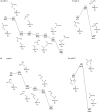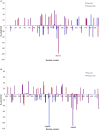Applications of density functional theory to iron-containing molecules of bioinorganic interest
- PMID: 24809043
- PMCID: PMC4010748
- DOI: 10.3389/fchem.2014.00014
Applications of density functional theory to iron-containing molecules of bioinorganic interest
Abstract
The past decades have seen an explosive growth in the application of density functional theory (DFT) methods to molecular systems that are of interest in a variety of scientific fields. Owing to its balanced accuracy and efficiency, DFT plays particularly useful roles in the theoretical investigation of large molecules. Even for biological molecules such as proteins, DFT finds application in the form of, e.g., hybrid quantum mechanics and molecular mechanics (QM/MM), in which DFT may be used as a QM method to describe a higher prioritized region in the system, while a MM force field may be used to describe remaining atoms. Iron-containing molecules are particularly important targets of DFT calculations. From the viewpoint of chemistry, this is mainly because iron is abundant on earth, iron plays powerful (and often enigmatic) roles in enzyme catalysis, and iron thus has the great potential for biomimetic catalysis of chemically difficult transformations. In this paper, we present a brief overview of several recent applications of DFT to iron-containing non-heme synthetic complexes, heme-type cytochrome P450 enzymes, and non-heme iron enzymes, all of which are of particular interest in the field of bioinorganic chemistry. Emphasis will be placed on our own work.
Keywords: QMMM; catalysis; density functional theory; enzyme reactions; iron-containing molecules; protein environment.
Figures























Similar articles
-
The valence bond way: reactivity patterns of cytochrome P450 enzymes and synthetic analogs.Acc Chem Res. 2010 Aug 17;43(8):1154-65. doi: 10.1021/ar100038u. Acc Chem Res. 2010. PMID: 20527755
-
New AMBER force field parameters of heme iron for cytochrome P450s determined by quantum chemical calculations of simplified models.J Comput Chem. 2005 Jun;26(8):818-26. doi: 10.1002/jcc.20221. J Comput Chem. 2005. PMID: 15812779
-
Quantum Mechanics/Molecular Mechanics Studies on the Relative Reactivities of Compound I and II in Cytochrome P450 Enzymes.Int J Mol Sci. 2018 Jul 6;19(7):1974. doi: 10.3390/ijms19071974. Int J Mol Sci. 2018. PMID: 29986417 Free PMC article.
-
Density functional theory (DFT) and combined quantum mechanical/molecular mechanics (QM/MM) studies on the oxygen activation step in nitric oxide synthase enzymes.Biochem Soc Trans. 2009 Apr;37(Pt 2):373-7. doi: 10.1042/BST0370373. Biochem Soc Trans. 2009. PMID: 19290865 Review.
-
Hybrid schemes based on quantum mechanics/molecular mechanics simulations goals to success, problems, and perspectives.Adv Protein Chem Struct Biol. 2011;85:81-142. doi: 10.1016/B978-0-12-386485-7.00003-X. Adv Protein Chem Struct Biol. 2011. PMID: 21920322 Review.
Cited by
-
Computational discovery of AKT serine/threonine kinase 1 inhibitors through shape screening for rheumatoid arthritis intervention.Mol Divers. 2025 Apr;29(2):1287-1303. doi: 10.1007/s11030-024-10910-z. Epub 2024 Jul 6. Mol Divers. 2025. PMID: 38970640
-
Ironing out pyoverdine's chromophore structure: serendipity or design?J Biol Inorg Chem. 2019 Aug;24(5):659-673. doi: 10.1007/s00775-019-01678-x. Epub 2019 Jun 18. J Biol Inorg Chem. 2019. PMID: 31214860
References
-
- ADF2012.01. (2012). SCM Theoretical Chemistry. Amsterdam: Vrije Universiteit; Available online at: http://www.scm.com
Publication types
LinkOut - more resources
Full Text Sources
Other Literature Sources
Miscellaneous

